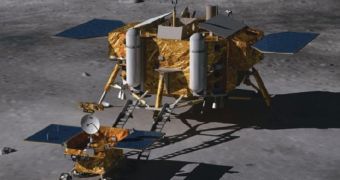The arrival of a Chinese lander on the Moon next month will cause some problems for the NASA Lunar Atmosphere and Dust Environment Explorer (LADEE) spacecraft. The vehicle is analyzing the lunar exosphere – the outermost layer of the atmosphere – for signs of dust and other chemicals.
As the Chang'e 3 lander will begin its descent and landing process, its carrier spacecraft will fire up its engines high above the Moon, to decelerate the spacecraft by as much as possible. This procedure will put significant amount of fuel debris in the lunar exosphere, making measurements more difficult for the NASA orbiter.
However, experts believe that this could be a good thing as well. NASA will get a chance to observe how a foreign chemical is spread in the lunar atmosphere, and how long it takes for it to disperse. Additionally, planetary scientists will be able to see how this clean-up process occurs.
Chang'e 3 is currently scheduled to blast off into space in early December. Upon arriving at the Moon, it will first fly a few orbits around Earth's natural satellite, conducting orbital observations before landing. Once on the ground, it will release a small, solar-powered rover that will conduct additional investigation of regolith (lunar soil), Space reports.
“The arrival of the Chang'e 3 spacecraft into lunar orbit and then its descent to the surface will result in a significant contamination of the lunar exosphere by the propellant,” says Johns Hopkins University Applied Physics Laboratory (JHU-APL) space scientist Jeff Plescia.
The expert is also the chairman of an organization called NASA Lunar Exploration Analysis Group (LEAD), which was founded to provide the American space agency with assistance in planning future Moon exploration missions.
“Propellant will be released at a relatively high altitude from burns as the Chang'e spacecraft enters lunar orbit and then at a range of altitudes as the spacecraft descends to the surface. LADEE will be able to observe how the propellant becomes distributed into the lunar exosphere and then how it is later removed,” Plescia adds.
LADEE may also be able to conduct a study of the plume of material that Chang'e 3 will produce as it fires its main thruster before landing. However, cooperation between the two missions is nearly impossible due to dissenting Republicans in Congress, who have forbidden NASA to engage in bilateral discussions with the Chinese space agency.

 14 DAY TRIAL //
14 DAY TRIAL //